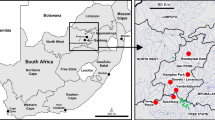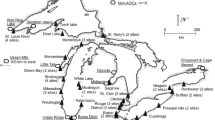Abstract
Organochlorine residues in eggs and prey species of the Peregrine Falcon,Falco peregrinus, were determined in parts of three south-eastern Australian States: Tasmania (1975–91), Victoria (1975–83) and South Australia (1977–1981). Relationships between residues detected and eggshell thickness, nest site occupancy and productivity were examined. Temporal changes and, in particular, the relative effects of DDE and dieldrin were also investigated. DDE was detected in all 137 eggs analysed. The concentration of DDE residues in eggs peaked in the late 1970s to early 1980s in Victoria, but peaked earlier and had declined to low concentrations by the 1980s in Tasmania. Maximum concentrations reached 82 ppm, in Victoria. The geometric means were: Victoria 12.4 ppm; Tasmania 1970s 10.1 ppm, 1980s 1.5 ppm; and South Australia 1.95 ppm. Dieldrin was detected in approximately half the eggs, but all except one egg (1.5 ppm) contained concentrations considered noncritical (<1 ppm). The degree of shell-thinning and reproductive success were related to DDE content, but not to that of dieldrin.
Organochlorine concentrations in prey reflected general concentrations in eggs and, with a few exceptions, were low. In Tasmania, reproductive success increased as DDE contamination declined. In Victoria, despite mean concentrations of DDE well above that considered to be critical for successful reproduction (>15–20 ppm) for at least seven years, the breeding population declined by <2% a year. We interpret this result as evidence that DDE causes a slow decline in population and that the dramatic declines observed in some other parts of the world were mainly attributable to contamination by dieldrin or to other confounding factors.
Similar content being viewed by others
References
Australian Academy of Science (1972)The Use of DDT in Australia. Aust. Acad. Sci. Rep. No. 14, Canberra.
Boersma, D.C., Ellenton, J.A. and Yagminas, A. (1986) Investigation of the hepatic mixed-function oxidase system in Herring gull embryos.Environ. Toxicol. Chem. 5, 309–18.
Cade, T.J., Enderson, J.H., Thelander, C.J. and White, C.M. (1988a)Peregrine Falcon Populations: Their Management and Recovery. Boise: The Peregrine Fund.
Cade, T.J., Enderson, J.H., Thelander, C.J. and White, C.M. (eds) (1988b) The role of organochlorine pesticides in peregrine population changes. InPeregrine Falcon Populations: Their Management and Recovery pp. 463–8. Boise: The Peregrine Fund.
Cooke, A.S. (1975) Pesticides and eggshell formation.Symp. Zool. Soc. Lond. 35, 339–61.
Court, G.S., Gates, C.C., Boag, D.A., MacNeil, J.D., Bradley, D.M., Fesser, A.C., Patterson, J.R., Stenhouse, G.B. and Oliphant, L.W. (1990) A toxicological assessment of Peregrines,Falco peregrinus tundrius, breeding in the Keewatin District of the Northwest Territories, Canada.Can. Field-Naturalist 104, 255–72.
De Weese, L.R., McEwen, G.L., Hensler, G.L. and Petersen, B.E. (1986) Organochlorine contaminants in passeriformes and other avian prey of the Peregrine Falcon in the western United States.Environ. Toxicol. Chem. 5, 675–93.
Enderson, J.H., Craig, G.R., Burnham, W.A. and Berger, D.D. (1982) Eggshell thinning and organochlorine residues in Rocky Mountain Peregrines and their prey.Can. Field-Naturalist 96, 255–64.
Falkenberg, I.D., Dennis, T.E. and Williams, B. (1991) Organochlorine contamination in White-bellied Sea Eagle, Osprey, Peregrine Falcon and prey species in South Australia. Report to South Australian Wildlife Conservation Fund, Department of Environment and Planning, Adelaide.
Ford, J. (1987) Australia pays to rid its beef of DDT and dieldrin.New Scientist 1579, 24.
Fyfe, R.W., Risebrough, R.W., Monk, J.G., Jarman, W.M., Anderson, D.W., Kiff, L.F., Lincer, J.L., Nisbet, I.T.C., Walker, W., II. and Walton, B.J. (1988) DDE, productivity, and eggshell thickness relationships in the genusFalco. InPeregrine Falcon Populations: Their Management and Recovery (Cade, T.J., Enderson, J.H., Thelander, C.G. and White, C.M., eds) pp. 319–35. Boise: The Peregrine Fund.
Hickey, J.J. (1969)Peregrine Falcon Populations: Their Biology and Decline. Madison: University of Wisconsin Press.
Hickey, J.J. and Anderson, D.W. (1968) Chlorinated hydrocarbons and eggshell changes in raptorial and fish-eating birds.Science 162, 271–3.
Hoffman, D.J., Rattner, B.A., Sileo, L., Docherty, D. and Kubiak, T. (1987) Embryotoxicology, teratogenicity and aryl hydrocarbon hydroxylase activity in Forster's Terns on Green Bay, Lake Michigan.Environ. Res. 42, 176–84.
Lincer, J.L. (1975) DDE-induced eggshell-thinning in the American Kestrel: a comparison of the field situation and laboratory results.J. Appl. Ecol. 12, 781–93.
Lockie, J.D., Ratcliffe, D.A. and Balharry, R. (1969) Breeding success and organochlorine residues in Golden Eagles in West Scotland.J. Appl. Ecol. 6, 381–9.
Mooney, N.J. and Brothers, N.P. (1987) The Peregrine FalconFalco peregrinus macropus S., in Tasmania. I. Distribution, abundance and physical characteristics of nests.Aust. Wildlife Res. 14, 81–93.
Newton, I. (1974) Changes attributable to pesticides in the nesting success of the Sparrowhawk in Britain.J. Appl. Ecol. 11, 95–101.
Newton, I. (1979)Population Ecology of Raptors. Berkhamstead: Poyser.
Newton, I. (1986)The Sparrowhawk. Calton: Poyser.
Newton, I. (1988) Changes in the status of the Peregrine Falcon in Europe: an overview. InPeregrine Falcon Populations: Their Management and Recovery (Cade, T.J., Enderson, J.H., Thelander, C.G. and White, C.M., eds) pp. 227–34. Boise: The Peregrine Fund.
Newton, I. and Haas, M.B. (1984) The return of the Sparrowhawk.Brit. Birds 77, 47–70.
Nisbet, I.C.T. (1988) The relative importance of DDE and dieldrin in the decline of Peregrine Falcon populations. InPeregrine Falcon Populations: Their Management and Recovery (Cade, T.J., Enderson, J.H., Thelander, C.G. and White, C.M., eds) pp. 351–75. Boise: The Peregrine Fund.
Noble, D.G. and Elliot, J.E. (1990) Levels of contaminants in Canadian raptors, 1966 to 1988; effects and temporal trends.Can. Field-Naturalist 104, 222–43.
Norris, K.C., Emison, W.B. and Bren, W.M. (1977) A preliminary survey of the population of Peregrine Falcons in Victoria.Emu 77, 86–7.
Olsen, P. (1985) Population studies of the Peregrine in Australia.ICBP Tech. Publ. 5, 381–8.
Olsen, P. and Olsen, J. (1979) Eggshell thinning in the peregrine,Falco peregrinus (Aves: Falconidae) in Australia.Aust. Wildlife Res. 6, 217–26.
Olsen, P. and Peakall, D.B. (1983) DDE in eggs of the Peregrine Falcon in Australia, 1949–1977.Emu 83, 276–7.
Olsen, P. and Olsen, J. (1985) Preliminary report on changes in egg-shell thickness in AustralianFalco species.ICBP Tech. Publ. 5, 389–92.
Olsen, P.D. and Olsen, J. (1988) Population trends, distribution, and status of the Peregrine Falcon in Australia. InPeregrine Falcon Populations: Their Management and Recovery (Cade, T.J., Enderson, J.H., Thelander, C.G. and White, C.M., eds) pp. 255–74. Boise: The Peregrine Fund.
Olsen, P. and Marples, T. (1992) Pesticide-related eggshell thinning in Australian raptors.Emu, in press.
Olsen, P., Settle, H. and Swift, R. (1980) Organochlorine residues in wings of ducks in Southeastern Australia.Aust. Wildlife Res. 7, 139–47.
Peakall, D.B. (1974) DDE: its presence in peregrine eggs in 1948. Science 183: 673–4.
Peakall, D.B. and Kiff, L.F. (1988) DDE contamination in Peregrines and American Kestrels and its effect on reproduction. InPeregrine Falcon Populations: Their Management and Recovery (Cade, T.J., Enderson, J.H., Thelander, C.G. and White, C.M., eds) pp. 337–50. Boise: The Peregrine Fund.
Peakall, D.B., Cade, T.J., White, C.M. and Haugh, J.R. (1975) Organochlorine residues in Alaskan Peregrines.Pesticides Monitoring J. 8, 255–60.
Peakall, D.B., Noble, D.G., Elliot, J.E., Somers, J.D. and Erickson, G. (1990) Environmental contaminants in Canadian Peregrine Falcons,Falco peregrinus: a toxicological assessment.Can. Field-Naturalist 104, 244–54.
Prestt, I. and Ratcliffe, D.A. (1972) Effects of organochlorine insecticides on European birdlife.Proceedings of the 15th International Ornithological Congress, pp. 486–513.
Pruett-Jones, S.G., White, C.M. and Emison, W.B. (1981) Eggshell thinning and organochlorine residues in eggs and prey of Peregrine Falcons in Victoria, Australia.Emu 80, 281–7.
Ratcliffe, D.A. (1967) Decrease in eggshell weight in certain birds of prey.Nature 215, 208–10.
Ratcliffe, D.A. (1970) Changes attributable to pesticides in egg breakage frequency and shell thickness in some British birds.J. Appl. Ecol. 7, 67–115.
Ratcliffe, D.A. (1972) The peregrine population in Great Britain in 1971.Bird Study 19, 117–56.
Ratcliffe, D.A. (1973) Studies of recent breeding success of the PeregineFalco peregrinus.J. Reprod. Fertility, Supplement 19, 377–89.
Ratcliffe, D.A. (1980)The Peregrine Falcon. Vermillion: Buteo Books.
Risebrough, R.W. (1986) Pesticides and bird populations. InCurrent Ornithology (Johnston, R.F., ed.) Vol. 3, pp. 397–427. New York: Plenum Press.
Risebrough, R.W. (1989) Toxic chemicals and birds of prey: discussions at Eilat in 1987. InRaptors in the Modern World (Meyburg, B.-U. and Chancellor, R.D., eds) London: WWGBP.
Risebrough, R.W. and Peakall, D.B. (1988) The relative importance of the several organochlorines in the decline of peregrine falcon populations. InPeregrine Falcon Populations: Their Management and Recovery (Cade, T.J., Enderson, J.H., Thelander, C.G. and White, C.M., eds) pp. 449–62. Boise: The Peregrine Fund.
Weimeyer, S.N., Porter, R.D., Hensler, G.L. and Maestrelli, J.R. (1986) DDE, DDT + dieldrin: residues in American Kestrels and relations to reproduction.Fish and Wildlife Technical Report 6. Washington: US Department of the Interior.
Author information
Authors and Affiliations
Rights and permissions
About this article
Cite this article
Olsen, P., Emison, B., Mooney, N. et al. DDT and dieldrin: effects on resident Peregrine Falcon populations in south-eastern Australia. Ecotoxicology 1, 89–100 (1992). https://doi.org/10.1007/BF00831890
Received:
Accepted:
Issue Date:
DOI: https://doi.org/10.1007/BF00831890




